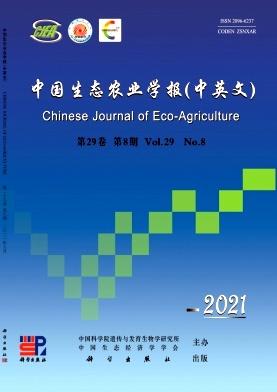Dynamic simulation of apple yield and dynamic response of deep soil moisture under rain-fed apple orchards of different planting densities at Baoji.
Q3 Agricultural and Biological Sciences
引用次数: 1
Abstract
More apples have been planted in recent years at Baoji,developing into a major apple cultivation area in the Loess Plateau where apple industry was critical for local rural economic development.Baoji is in a semi-humid climate zone where apple orchards are mainly rain-fed without artificial irrigation.Because apples need plenty water for growth,there has been deep soil desiccation in apple orchard fields which has in turn caused severe fluctuations in apple yield.Thus apple production bases in the region have faced a serious threat to sustainable,long-term development.To determine long-term variations in yield and soil water of rain-fed apple orchards of different planting densities in semi-humid climate tableland and gully-land regions of the Loess Plateau,apple yield and the 0 15 m layer soil moisture dynamics in apple orchards of 6 different planting densities at Baoji in 1965—2009 were quantitatively simulated and analyzed using the WinEPIC model.From planting densities of D1(2 m × 3 m),D2(2 m × 4 m),D3(2.5 m × 4 m),D4(3 m × 4 m),D5(4 m × 4 m) and D6(4 m × 5 m),and planting years of 1 45 years,the study determined the optimum planting density and cultivation period of rain-fed apple orchards.The results showed that for the 42 years(1968—2009) of apple production,yields of apple orchards of different planting densities initially increased gradually and then declined with severe fluctuations.The average apple yield of the first 21 years was significantly higher than that of the second 21 years in the 42 years of apple production.Apple yield improved with increasing planting density from D1 to D3 and some times D4,which was 833 1 000 plants per hectare.Apple yields of different planting densities changed positively with precipitation trend.With increasing planting density,soil available water capacity in the 0 15 m soil layer in apple orchards decreased,while formation rate of dried deep soil layer increased.Based on the trend and amplitude of variations in yield during 1968—2009,the number of drought stress day,available soil water capacity and soil moisture distribution,the optimum planting density was D3 or D4,and the optimum cultivation period of rain-fed apple orchards was 30 years at Baoji.宝鸡市不同种植密度雨养苹果园苹果产量动态模拟及深层土壤水分动态响应
近年来,宝鸡市苹果种植面积不断扩大,已发展成为黄土高原苹果主产区,苹果产业对当地农村经济发展至关重要。宝鸡地处半湿润气候区,苹果园主要靠雨水灌溉,无需人工灌溉。由于苹果生长需要大量的水分,苹果园的土壤严重干燥,这反过来又造成了苹果产量的严重波动。因此,该地区的苹果生产基地面临着可持续、长期发展的严重威胁。为确定黄土高原半湿润气候台塬沟壑区不同种植密度雨养苹果园产量和土壤水分的长期变化规律,利用WinEPIC模型对1965-2009年宝鸡市6个不同种植密度苹果园的苹果产量和0 - 15 m层土壤水分动态进行了定量模拟和分析。根据D1(2 m × 3 m)、D2(2 m × 4 m)、D3(2.5 m × 4 m)、D4(3 m × 4 m)、D5(4 m × 4 m)、D6(4 m × 5 m)的种植密度和种植年限,确定了雨养苹果园的最佳种植密度和栽培年限。结果表明,在苹果生产的42年间(1968-2009),不同种植密度苹果园的产量呈现先逐渐上升后急剧下降的趋势。42年苹果产量中,前21年苹果平均产量显著高于后21年。苹果产量随D1 ~ D3间或D4种植密度的增加而提高,达到833万株/公顷。不同种植密度的苹果产量随降水趋势呈正相关变化。随着种植密度的增加,苹果园0 ~ 15 m土层土壤有效水量降低,而干深层形成速率增加。综合考虑1968—2009年产量变化趋势和幅度、干旱胁迫日数、有效土壤水分容量和土壤水分分布,宝鸡市雨养苹果园的最佳种植密度为D3或D4,最佳栽培期为30 a。
本文章由计算机程序翻译,如有差异,请以英文原文为准。
求助全文
约1分钟内获得全文
求助全文
来源期刊

Chinese Journal of Eco-agriculture
Environmental Science-Ecology
CiteScore
2.70
自引率
0.00%
发文量
0
 求助内容:
求助内容: 应助结果提醒方式:
应助结果提醒方式:


